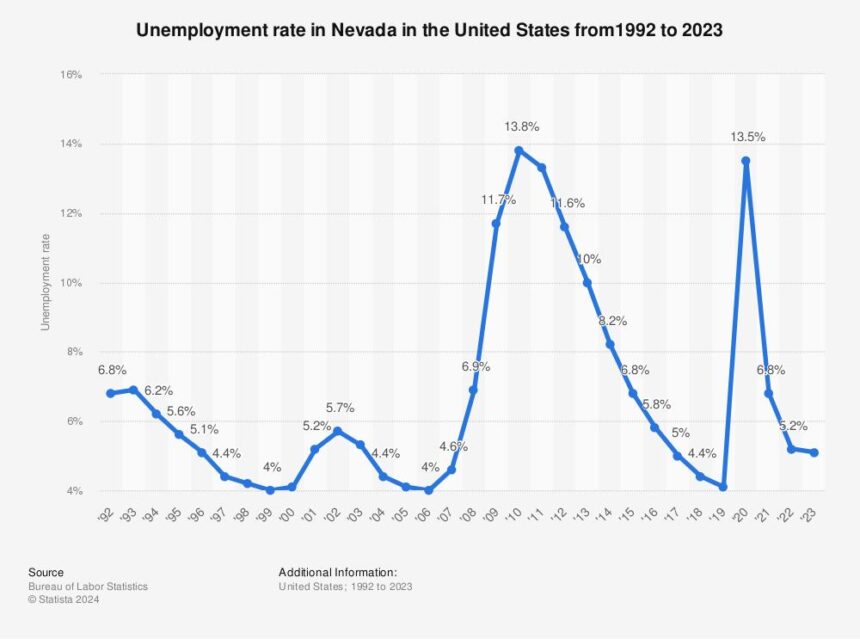Nevada’s Labor Market Shows Slight Betterment Amid Ongoing Economic Hurdles
Nevada’s unemployment rate has experienced a modest decrease, hinting at a gradual recovery within the state’s employment sector. Although the progress is subtle, it offers a hopeful sign amid persistent economic uncertainties. This article delves into the latest employment patterns in Nevada,analyzing the driving forces behind the slow reduction in joblessness and the implications for workers and businesses in the near future.
Gradual Reduction in Nevada’s Unemployment Rate Despite Economic Headwinds
Despite ongoing challenges such as fluctuating tourism demand and transformations within the service industries,recent data reveals a slight improvement in Nevada’s job market. The unemployment rate has edged downward, reflecting a cautious sense of optimism among employers and job seekers. Though, experts caution that this decline is incremental and may not immediately lead to significant economic expansion.
Key contributors to the current employment trends include:
- Tourism and Hospitality: A modest rise in seasonal employment, even as global travel uncertainties persist.
- Construction Sector: Continued demand tempered by ongoing supply chain disruptions and rising material costs.
- Technology and Remote Work: Emerging job opportunities in tech-driven roles and telecommuting positions.
| Month | Unemployment Rate (%) | Monthly Change |
|---|---|---|
| March 2024 | 5.1 | -0.1 |
| February 2024 | 5.2 | 0.0 |
| January 2024 | 5.2 | +0.1 |
Industry Breakdown: Sectors Leading Nevada’s Employment Growth
Recent employment statistics indicate a slow but steady movement toward stabilization in Nevada’s workforce, with certain industries showing stronger performance. The leisure and hospitality sector, a vital component of the state’s economy, continues to recover, contributing significantly to the modest job growth seen in recent months. Similarly, healthcare and social assistance sectors have expanded their workforce despite broader economic pressures, reflecting sustained demand for essential services.
Moreover, newer industries such as technology and clean energy are beginning to influence employment patterns, signaling a diversification away from Nevada’s traditional dependence on tourism and gaming.The table below highlights the year-over-year employment changes across key sectors:
| Industry | Employment Growth (%) |
|---|---|
| Leisure & Hospitality | +2.1% |
| Healthcare & Social Assistance | +1.4% |
| Technology | +0.7% |
| Renewable Energy | +0.5% |
Challenges Hindering Workforce Expansion: Expert Perspectives
Despite the slight improvement in unemployment figures, experts identify several significant barriers that continue to restrict workforce growth in Nevada.A prominent issue is the persistent mismatch between available jobs and the skills of job seekers,particularly in technology and advanced manufacturing sectors. Additionally, the rising cost of living, especially housing affordability, discourages many potential workers from entering or remaining in the labor market.
Other obstacles impacting workforce participation include:
- Complex regulatory environments that hinder small business growth
- Limited childcare options, which restrict parents’ ability to work
- Concerns over the affordability and accessibility of healthcare coverage
| Barrier | Effect on Workforce | Proposed Solutions |
|---|---|---|
| Skills Gap | Lower employment rates | Expanded vocational and technical training programs |
| Housing Affordability | Worker migration out of state | Growth of affordable housing projects |
| Childcare Shortages | Reduced labor force participation | Increased funding for childcare subsidies |
Strategic Policy Initiatives to Boost Employment and Economic Stability
To foster a more dynamic and resilient job market, Nevada must implement focused policy measures.Prioritizing investments in workforce development programs tailored to high-growth sectors such as renewable energy, technology, and advanced manufacturing will better prepare residents for future job opportunities. Supporting small businesses through simplified licensing procedures and improved access to financing can also stimulate local job creation.
Addressing childcare availability is critical to enabling more parents to join or return to the workforce. Furthermore, enhancing labor protections and promoting competitive wages will help improve job retention and overall employment quality. Below is a summary of recommended policy actions:
- Expand skills training: Develop targeted programs aligned with industry needs.
- Support entrepreneurship: Provide grants and mentorship for startups and small businesses.
- Increase childcare support: Offer subsidies and expand childcare services for working families.
- Raise wage standards: Adjust minimum wages to keep pace with inflation and living expenses.
- Promote job security: Encourage employers to offer long-term contracts and benefits.
| Policy Focus | Expected Outcome | Priority |
|---|---|---|
| Workforce Development | Better job matching, reduced unemployment | High |
| Small Business Assistance | Increased employment, economic diversification | Medium |
| Childcare Expansion | Higher labor participation rates | High |
| Wage and Benefit Improvements | Lower turnover, improved living standards | Medium |
Looking Ahead: Navigating Nevada’s Employment Future
As Nevada’s unemployment rate continues its slow descent, the labor market shows signs of cautious optimism. While the pace of improvement remains gradual, these incremental gains suggest a potential path toward greater economic stability. Ongoing collaboration between policymakers, industry leaders, and community stakeholders will be essential to sustain growth and expand job opportunities for Nevada’s workforce in the coming years.








